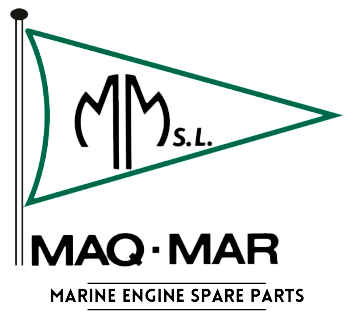Centrifugal pumps are the most commonly used hydraulic pumps for pumping low-viscosity liquids such as water or corrosive liquids. You will find that they are also called rotodynamic pumps. This type of pump generates the pressure necessary for a fluid to move from one place to another. They have various applications: for domestic use, for the chemical industry, the cosmetics industry, the food industry and, of course, for ships.
How does a centrifugal pump work?
- The fluid enters the pump through the impeller. This impeller is driven by a motor attached to a shaft. It has a disc with blades that serves to create kinetic energy that directs the fluid through the pump.
- The fluid is propelled outwards due to the centrifugal force produced by the pump, and is collected by the pump casing or pump body.
- The fluid is directed to the outlet pipes or to the next impeller.
What are the parts of a centrifugal pump?
A centrifugal pump is made up of several parts, we will explain the main ones:
- Casing: part that protects the inside of the pump. They are made of different materials depending on their purpose: cast iron if it is used to pump drinkable water, or stainless steel or bronze if it is intended to pump a liquid that is very corrosive.
- Inlet and outlet pipes: conduits through which the water circulates. The inlet pipe is known as the suction pipe and the outlet pipe is known as the drive pipe.
- Impeller: the part that rotates inside the pump casing. It produces the pressure necessary to propel the water contained in the casing. It is usually made of bronze.
- Diffuser: has blades that surround the impeller and reduce the speed of the fluid, which increases the pressure.
- Shaft: it is responsible for supporting the impeller so that it rotates on it with the force of the motor. It is usually made of stainless steel.
- Bearings: support the impeller shaft and reduce friction between the moving parts.
- Motor: allows the shaft and impeller to move at the same time to achieve water movement. The more power it has, the more water it can move in less time. It can be electric or combustion. At MAQMAR we usually sell a greater number of pumps with an electric motor.
- Volute: this is a metal part that forms part of the casing that surrounds the impeller and controls the amount of pressure generated by the impeller.
Advantages of centrifugal pumps
- Low cost: they are cheaper compared to other pumps. They usually range from about €2,000 to €37,000 depending on characteristics such as kW, v, rpm, etc.
- Easy maintenance: centrifugal pumps are cheap and easy to maintain. At MAQMAR you can get repair and maintenance kits or spare parts separately, as you prefer.
- Versatile: they can be used for many kinds of liquids: water, chemicals, fuels, etc.
- Small dimensions: are lightweight and space-saving.
Types of centrifugal pumps
There are many types of centrifugal pumps on the market, depending on different criteria such as the liquid to be pumped, type of application, flow rate and pressure required. Some types are:
Depending on the shaft arrangement:
- Horizontal
- Vertical
Depending on the number of impellers:
- Single-stage: contain a single impeller.
- Multi-stage: containing two or more impellers.
If you still have any doubts and do not know which type of pump best suits your pumping needs, please contact us so that we can help you choose.


Recent Comments